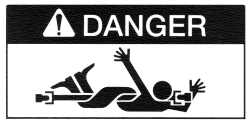A PTO shaft revolving at 540 rpm travels more than two meters in less than a second. Little wonder that PTO entanglement nearly always results in devastating injury or death!
Missing or damaged shielding is the main reason for driveline entanglement. Manufacturers have made tremendous strides in developing safer PTO shielding. However, it is impossible to make protection fool proof. All shielding components must be correctly installed and properly maintained to prevent injury in case of accidental contact.
Operator awareness and constant vigilance are also crucial if PTO entanglement is to be avoided. Making repairs while equipment is operating, stepping over or onto revolving shafts, wearing loose or frayed clothing are actions that set the stage for carnage.
Clear safety rules must be established for everyone who works with farm machinery. Even the most experienced operator will benefit by reviewing the PTO safety information summarized in this fact sheet. The guidelines will prove especially valuable for training novice equipment operators -- new employees and children who are excited about the prospect of operating farm machinery must be made aware of the importance of sticking to these rules!

Integral-journal shields completely enclose the power shafts of PTO-operated machines. Manufacturers have made great strides in the design of these tubular shields, most of which are now made of durable plastic. The "cones" that cover the universal joints at each end of a plastic power shaft shield have also been improved - their flexible design makes hook-up easier and provides greater protective cover.
Integral shields rotate on bearings, independently of the power shaft. They revolve with the shaft while it is turning, but the shield will stop spinning if it is contacted. These shields must be kept in place and maintained in good condition to provide protection against the grabbing action of shafts and universal joints.
The power shaft must also be shielded at the point of attachment of the driven machine. Both the universal joint and the machine's stub shaft must be well covered. If this shielding is missing or damaged, or if you feel it doesn't provide adequate protection, talk to your dealer about a replacement.
There are still some older machines in operation that have tunnel shields over their power shafts. This design offered only limited protection. Because tunnel shielding is still open at the bottom, clothing, shoelaces, hair, etc. can be caught by the shaft or universal joints. There is a case to be made for "retiring" such equipment. If it must be used, power shafts and shielding should be replaced with safer, modern components.
Proper installationNew equipment is fitted with the driveline recommended for that particular machine. Make very sure that all replacement driveline components conform to the same specifications.
The tractor drawbar should be adjusted to the length specified in the driven machine's manual. This ensures that the telescoping power shaft and shield will stay together when they lengthen in operation. It also prevents driveline "bottoming out" when making a sharp turn, or when the rear tractor wheels enter a depression. This puts considerable strain on shaft and bearing supports, and the entire driveline may be damaged or bent.
Use your safety senseFollowing are key considerations for preventing PTO entanglement.
Publication #: F-020
The information and recommendations contained in this publication are believed to be reliable and representative of contemporary expert opinion on the subject material. The Farm Safety Association does not guarantee absolute accuracy or sufficiency of subject material, nor can it accept responsibility for health and safety recommendations that may have been omitted due to particular and exceptional conditions and circumstances.
Farm Safety Association Home Page
Disclaimer and Reproduction Information: Information in NASD does not represent NIOSH policy. Information included in NASD appears by permission of the author and/or copyright holder. More